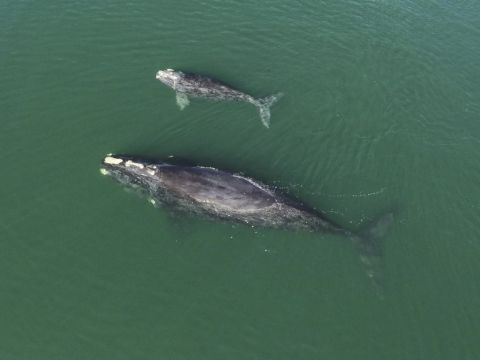North Atlantic right whales gave birth over the winter in greater numbers than scientists have seen since 2015.
It is an encouraging sign for researchers who became alarmed three years ago when the critically endangered species produced no known offspring at all.
Survey teams spotted 17 newborn right whale calves swimming with their mothers offshore between Florida and North Carolina, in the US, from December to March.
One of those calves soon died after being hit a boat, a reminder of the high death rate for right whales that experts fear is outpacing births.
The overall calf count equals the combined total for the previous three years.

That includes the dismal 2018 calving season, when scientists saw zero right whale births for the first time in three decades.
Researchers say greater numbers are needed in the coming years for North Atlantic right whales to rebound from an estimated population that has dwindled to about 360.
“What we are seeing is what we hope will be the beginning of an upward climb in calving that’s going to continue for the next few years,” said Clay George, a wildlife biologist who oversees right whale surveys for the Georgia Department of Natural Resources.
“They need to be producing about two dozen calves per year for the population to stabilise and continue to grow again.”
Right whales migrate each winter to the warmer Atlantic waters off the south-eastern US to give birth.
Trained spotters fly over the coastline almost daily during the calving season, scanning the water for mothers with newborns.
Survey flights over Georgia and Florida ended Wednesday on the last day of March, typically the season’s end.
Spotters will monitor waters off the Carolinas until April 15, hoping to pick up any overlooked newborns as the whales head north to their feeding grounds.
This season’s calf count matches the 17 births recorded in 2015. Right whale experts consider that number fairly average, considering the record is 39 births confirmed in 2009.
Scientists suspect a calving slump in recent years may have been caused by a shortage of zooplankton to feed right whales in the Gulf of Maine and the Bay of Fundy off Nova Scotia.
They say the rise in births this season could be a result of whales being healthier after shifting to waters with more abundant food sources.
“It’s a somewhat hopeful sign that they are starting to adjust to this new regime where females are in good enough condition to give birth,” said Philip Hamilton, a right whale researcher at the New England Aquarium in Boston.
Regardless, conservationists worry that right whales are dying, largely from manmade causes, at a faster rate than they can reproduce.
Since 2017, scientists have confirmed 34 right whale deaths in waters of the US and Canada, with the leading causes being entanglement in fishing gear and collisions with boats and ships.







